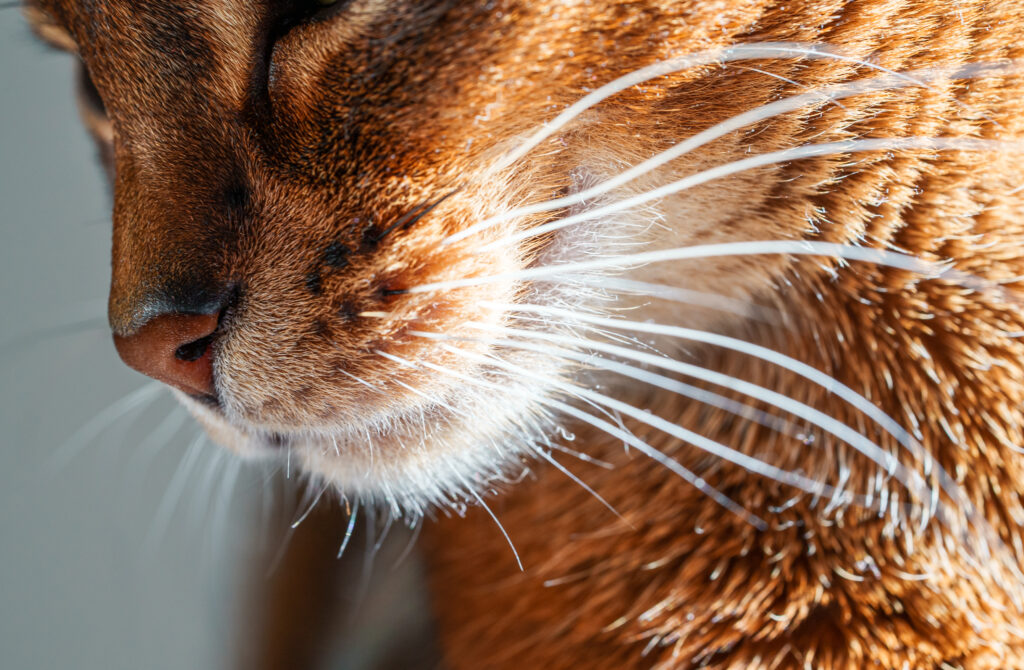
Whiskers are more than mere decorative hairs on a cat’s face; they are highly specialized sensory organs integral to a cat’s ability to navigate its environment. These fine, sensitive protrusions are crucial extensions of a cat’s nervous system, facilitating an array of functions that contribute to their survival and well-being.
Cats possess a unique anatomical feature with their whiskers, finely attuned to touch and vibration. They play a vital role in a cat’s sensory perception, enhancing their ability to navigate, communicate, and understand their surroundings:
Estimating Space and Size: Whiskers help cats gauge whether they can fit through openings, acting like a biological measuring stick. This is particularly useful for ensuring their safety while squeezing through tight spaces.
Communicating Emotions: Whiskers can indicate a cat’s emotional state. A relaxed cat will typically have its whiskers in a neutral position, while an agitated or fearful cat may hold its whiskers back or have them raised, signaling its discomfort or readiness to defend itself.
Hunting and Prey Detection: Cats use their whiskers to detect movements and vibrations, critical for hunting. The sensitivity of these hairs helps detect even the faintest movements of prey, ensuring their success as hunters.
Protective Mechanism: Whiskers help protect cats from potential hazards. Their spatial awareness, aided by whiskers, ensures they avoid dangerous situations, minimizing the risk of injury.
Sensing the Surroundings: Whiskers act as sensory antennae, enabling cats to gather detailed information about their environment, including the presence of other animals or objects, contributing to their overall awareness and responsiveness.
Different types of whiskers serve distinct functions, each contributing to a comprehensive sensory network. These include:
Located on either side of the muzzle in horizontal rows, mystacial whiskers are the most prominent. Their primary functions include:
Navigation: They detect air currents and help cats sense nearby objects.
Space Estimation: Whiskers extend outward, allowing cats to assess whether they can fit through openings.
Emotional Indicators: The position of these whiskers can reflect a cat’s mood, signaling its state of comfort or distress.
These shorter, flexible whiskers sit above a cat’s eyes. Their functions include:
Eye Protection: Superciliary whiskers signal impending danger to the eyes, helping to avoid potential injury.
Enhanced Sensory Perception: They assist in detecting changes in the environment.
Located on the cheeks, genal whiskers serve to:
Augment Sensory Input: They provide additional feedback about the cat’s immediate environment.
Facilitate Social Interaction: These whiskers often play a role during social exchanges with other cats or humans.
Found on the backs of a cat’s front legs, carpal whiskers have critical functions:
Navigation: They help cats when climbing or making quick movements during a hunt.
Prey Assessment: Essential for detecting minute movements of prey, ensuring effective hunting.
Whiskers offer cats the ability to perceive a variety of sensory information that is vital for their survival:
Air Currents and Wind Direction: Sensitivity to air currents allows cats to sense the environment’s dynamics, crucial for hunting and avoiding threats.
Objects and Obstacles: Whiskers help prevent unwanted collisions, guiding cats safely around their surroundings.
Size and Shape Recognition: They provide feedback about the dimensions and contours of nearby objects, aiding in navigation.
Whiskers are far more than just hairs; they are intricate sensory tools that enhance a cat’s ability to interact with its environment. Through a combination of navigation, communication, and protective functions, whiskers bolster a cat’s instinctual prowess, proving essential for its survival in a complex world. Understanding the importance of whiskers deepens our appreciation for these remarkable creatures and their unique adaptations.
Pet Taxi
Our pet taxi service is perfect for giving your dog, cat, or small animal a ride to and from appointments or events when you can't take them yourself. It's particularly handy for trips to the vet!
Pet Visits
Are you going on a holiday or just away for a day? We can visit your pet once or twice a day while you're away, so you can kick back and enjoy your time stress-free, knowing your pet is in dafe hands and being regularly visited.
Weddings & Days out
Getting married? Our packages let your furry friend join your big day! Dog Days Out: Adventure walks for dogs of all ages and sizes (except tiny puppies). Ideal for exploring new places and getting extra walking time.